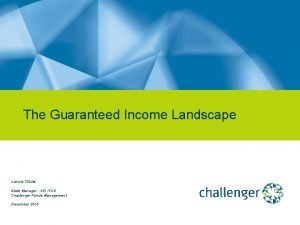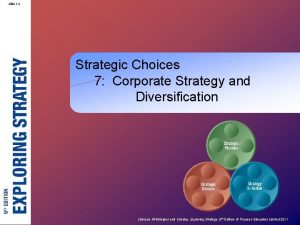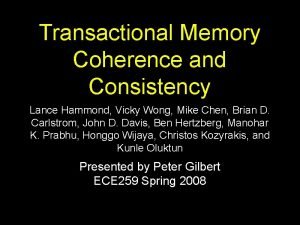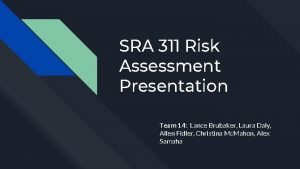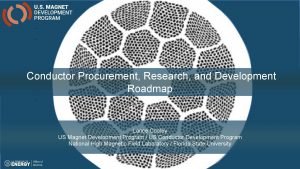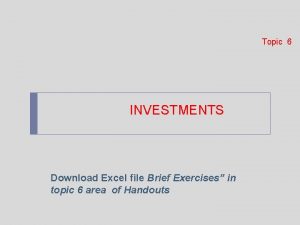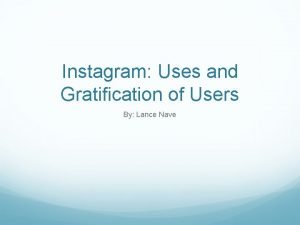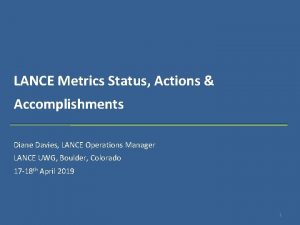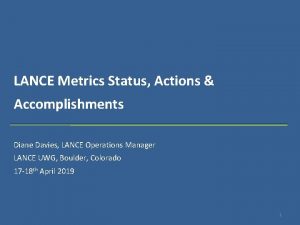The Guaranteed Income Landscape Lance Oliver State Manager















































- Slides: 47

The Guaranteed Income Landscape Lance Oliver State Manager - VIC /TAS Challenger Funds Management December 2010

Disclaimer The information contained in this presentation is current as at 30 November 2010 unless otherwise specified and has been prepared by Challenger Life Company Limited ABN 44 072 486 938 AFSL 234670. It is intended solely for licensed financial advisers. It must not be passed on to a retail client except where it is included as part of the financial adviser's own advice to their client and is not accredited to Challenger. Any information provided or conclusions made, whether express or implied, do not take into account the investment objectives, financial situation and particular needs of an investor. This presentation has not been prepared to provide recommendations for any particular individuals. The examples used are for the purposes of illustration only. Individuals should seek expert financial planning advice to determine suitable recommendations for individual circumstances. All information has been obtained from sources believed to be reliable and accurate at the time of publication. The taxation and Centrelink illustrations are based on current law at the time of writing, which may change at a future date. Challenger Life Company Limited is not licensed or authorised to provide tax advice. We strongly recommend that an investor seeks professional taxation and social security advice for their individual circumstances. All reasonable care has been taken to ensure correctness of facts stated and the examples given, and to ensure that they are fair and reasonable. We make no warranty in relation to, nor accept any responsibility or any liability for any errors or misstatements nor for any loss or damage arising out of, or in relation to the material in this presentation, however caused. Past performance is not a reliable indicator of future performance. Offers of interests in the Challenger Guaranteed Income Plan (Lifetime Annuity) & Challenger Guaranteed Annuity (Lifetime) are contained in the relevant current Product Disclosure Statement (PDS) issued by Challenger Life Company Limited which is available on our website www. challenger. com. au and should be considered before making any decision about the product. 2

Agenda 3 • Considerations for Retirees • Pre v Post Retirement Considerations • Market Risk • Longevity Risk • A look at Annuities • The Annuity Market • Some Popular Strategies • Guaranteeing Basic Income Needs • Funding SMSF Payments • Conclusion

Introduction 2010 is the first year that baby boomers retire (1945 + 65 = 2010) The GFC has resulted in the evaporation of an enormous amount of wealth worldwide. 2009 OECD Global Survey found 4 • The average retiree has experienced significant wealth reduction over the past two years. • Australian superannuation funds had the highest exposure to equities and were third worst performing group of pension funds in the world over 2009. • Retirees are now facing the significant problem of being under-funded in retirement in order to cover their life expectancy. • Australia has 4 th most pensioners living below the poverty line

Key Considerations for Retirees Market Risk Longevity Risk Dramatically increases likelihood of early depletion of retirement assets People are living longer They need to consider the possibility of living MUCH longer 5 5

Considerations for Retirees “Market Risk”

Investment objectives – pre v post retirement Income versus Growth • Accumulators aim to maximise wealth through capital growth while retirees have a preference for income to meet living expenses Financial Capital versus Human Capital • 7 Accumulators have the ability to control the date of retirement and hence continue to add to their capital base, while retirees don’t have that ability after retirement

Differences between pre & post retirement Maximum at Retirement Minimum Retirement 8

Impact of market downturn at different times during the accumulation phase Scenario 1: 7. 5%p. a. constant return Scenario 2: -25% return at age 30, 7. 5%p. a. every other year Scenario 3: -25% return at age 59, 7. 5%p. a. every other year Wealth $600, 000 Point of maximum wealth / hypersensitive to downturn $500, 000 $400, 000 $300, 000 $200, 000 Compound effect works in your favour $100, 000 $0 25 30 35 40 45 Age 9 Assumptions: Accumulation begins at age 25 50 55 60

Impact of market downturn during different times during the decumulation phase Scenario 1: 7. 5%p. a. constant return Scenario 2: -25% return at age 62, 7. 5%p. a. every other year Scenario 3: -25% return at age 85, 7. 5%p. a. every other year Wealth $600, 000 Point of maximum wealth / hypersensitive to downturn $500, 000 Compound effect works against you $400, 000 $300, 000 $200, 000 $100, 000 22 Years 5 Years $0 61 66 71 76 81 Age Assumptions: Decumulation begins at age 61 10 Annual drawdown of $40, 080 86 91 96

More shares are not the answer Pension fund asset allocation for selected investment categories 11 Source: OECD Global Pension Statistics (October 2009)

Considerations for Retirees “Longevity Risk”

The Australian Scenario • Average life expectancy grows by one year every six years • The latest Treasury Intergenerational Report uses longevity assumptions for 2040 which show: – a 60 year old man will have life expectancy of slightly <90 years – a 60 year old female will have life expectancy slightly >90 years • That means a significant number of retirees will be living well into their 90’s and beyond. 13

Allocated Pensions and Longevity Risk Starting account balance $500, 000 $300, 000 $150, 000 $50, 000 Target income Age 60 retiree Age 65 retiree Modest n/a Comfortable 84 89 Modest n/a Comfortable 71 80 Modest 72 n/a Comfortable 65 71 Modest 63 81 Comfortable 62 67 Note: Incomes include age pension entitlements and are based on a 50/50 growth/defensive asset allocation Source: Retirement income modelling results, Towers Perrin 5 March 2009 ASFA/Westpac (Includes Commonwealth Age Pension entitlements Modest = $19, 400, Comfortable = $37, 452 14 14

The significance of demographic change • At present, developed countries on average have about four people of working age for every person over 65. By 2050 this reduces to only two workers for every pensioner. • Australia faces similar demographic changes to other OECD nations – When pension at 65 yrs was introduced in 1909 average male life expectancy was 55 yrs – today it is 80 yrs – 1969 (8%); 2009 (13%); 2049 retiree segment to almost double (22%) in 40 years • Total cost of managing an aging population is far greater than the cost of the GFC. 15 15 Source: The Economist; Australian Treasury IGR 3

Ageing population driving defensive asset growth Australian population growth 2008 - 2028 1616 Inferred growth of fixed income products using a ‘Glide Path’ approach

Challenger & The Annuity Market

Challenger Group Structure Life Challenger Life Company Limited (APRA regulated Life Company) $7. 4 bn of AUM at 30 Sept 2010 18 Funds Management A fiduciary funds management operation manufacturing and distributing quality investment products for both institutional and retail clients $21. 8 bn of AUM at 30 Sept 2010

Challenger Group Structure Life Challenger Life Company Limited (APRA regulated Life Company) Manages a portfolio of assets delivering long term guaranteed income streams to annuitants and predictable over-the-cycle returns to shareholders $7. 4 bn of AUM at 30 Sept 2010 Market leader in annuities with 60, 000+ policy holders Clear investment strategy & focus on risk and capital management Investment strategy focussed on assets generating predictable income streams Product Suite 19 • Guaranteed Income Plan (Retail) • Guaranteed Annuity (Retail) • Liquid Lifetime (Retail) • Guaranteed Super and Pension (Retail) • Guaranteed Income Fund (IDPS / Platfoms)

The annuities market Total size of annuity funds ($m) at 31 December 2009 $324 m $30 m $4, 135 m $473 m $1, 369 m $214 m $3, 622 m $14 m Source: Plan for Life, Actuaries and Researchers, 31 December 2009. 20 Total annuity inflows ($m) – last 12 months to 31 December 2009

Annuity Market Rates Short term 21 Long term Source: For week commencing 29 th November 2010 Data compiled by Challenger from Plan for Life, Researchers and Actuaries, Weekly Immediate Annuities Reports. All annuity rates based on Maximum upfront and Nil Trail commission. Rates are based on monthly payments. Past performance is not an indicator of future performance.

Some popular strategies Guaranteeing Basic Income Needs Short Medium Long

Guaranteeing basic income needs Common Structure: 23 Account Based Pension • • Exposed to growth Income Assets Minimum drawdown funds income Longevity depends on capital movement and drawdown rate Age Pension • • • Provides “income floor” for basic needs Is linked to CPI No Longevity Risk

Guaranteeing basic income needs Strategy: Account Based Pension Long Term Annuity • • Exposed to growth Income Assets Minimum drawdown funds income Longevity depends on capital movement and drawdown rate • Provides more robust “income floor” for basic needs Is linked to CPI No Longevity Risk • • Age Pension 24

Guaranteeing basic income needs Case study • • • Rod (65) and Sandra (64) own their own home and have $20, 000 personal assets and $50, 000 in ordinary investments Rod is retiring with $500, 000 in his super fund Sandra doesn’t work and has no superannuation Strategy: • • 25 Secure basic income needs via guaranteed annuity payments + Age Pension – Timeframe determined 20 years Remaining funds used to commence account based pension

Guaranteeing basic income needs • Requires $25, 000 p. a. to cover basic income needs • Would like $50, 000 p. a. for comfortable lifestyle Strategy: • • Purchase 20 year term, CPI indexed annuity for $152, 000* – Income in year one $10, 542 Age pension entitlement $15, 100 (combined) Total annuity and Age Pension income = $25, 642 Account based pension - $348, 000 – Minimum income = $17, 400 *Challenger annuity quote 24/03/2010, 20 year term, CPI indexed, monthly income, 3. 3% upfront commission, nil trail 26

Guaranteeing basic income needs 27 Source: Challenger Assumptions: Inflation 3%, earning rate on account based pension 7% and financial investments 3%, Income requirements $50, 000, min drawdown on pension, income deficit funded via pension commutations, surplus income added to financial investments

Guaranteeing basic income needs • Case study outcomes: – Basic income needs covered over next 20 years regardless of market conditions – Annuity and Age Pension income linked to inflation – 72% of overall financial assets remain fully accessible with control over investment choice – Tax free income from annuity & account based pension – Helps address concerns over longevity risk 28

Some popular strategies Funding SMSF Payments Short Medium Long

Funding SMSF payments 30 • SMSF funds have had to crystallise losses over last couple of years to make pension payments • May take years to recover from negative investment returns • Use annuity as part of portfolio to make income payments – Critical to meet minimum payment requirements to preserve tax exempt status of pension assets • Growth assets remain in tact and able to recover in times of volatile markets

Funding SMSF payments SMSF Aged based pension payments Equities ? Property § Circumvent realising capital losses by selling assets at distressed price CMT Nil RCV § Larger allocation to growth assets which are invested for longer § Income payments guaranteed by Life company 31

Funding SMSF payments – How much to allocate? SMSF balance $500, 000 4% 5% 6% $20, 000 $25, 000 $30, 000 Income required (%) $ Income (pa) Annuity term 3 4 5 6 Annuity rate 6. 13% 6. 28% 6. 33% 6. 36% Guaranteed Annuity Rates for as week commencing 6 th December Earnings Rate for Monthly Income Payments No Indexation applied to income payments 32

Funding SMSF payments – How much to allocate? Income 4% Terms 3 4 5 6 $54, 679 $70, 581 $85, 529 $99, 542 10. 9% 14. 1% 17. 1% 19. 9% $445, 321 $429, 419 $414, 471 $400, 458 3. 9% 3. 8% $68, 349 $88, 226 $106, 911 $124, 427 13. 7% 17. 6% 21. 4% 24. 9% $431, 651 $411, 774 $393, 089 $375, 573 5. 0% 4. 9% $82, 019 $105, 871 $128, 293 $149, 313 Amount into annuity Percentage of SMSF balance Balance in SMSF Return required to replenish capital 5% Amount into annuity Percentage of SMSF balance Balance in SMSF Return required to replenish capital 6% Amount into annuity Percentage of SMSF balance 16. 4% 21. 2% 25. 7% 29. 9% Balance in SMSF $417, 981 $394, 129 $371, 707 $350, 687 Return required to replensish capital 6. 1% Guaranteed Annuity Rates for as week commencing 6 th December Earnings Rate for Monthly Income Payments No Indexation applied to income payments 33 6. 2% 6. 1%

Funding Strategy - How to implement “Stepping” • • At commencement purchase 3 separate terms (eg. $300 K split into 3 x $100 K across 1, 2 & 3 year terms). • Strategy used to create a regular liquidity event & help mitigate interest rate risk Maturity profile then results in a regular liquidity event (eg. On maturity every year purchase a new 3 year term). START 34 1 2 3 4 5 6 7 8

Conclusion

The case for annuities • Annuities are return & term certain – • Annuities exhibit zero volatility – • 36 an annuity effectively allows the investor to outsource the marked to market variation in capital value of their assets to the life company. Annuities are issued by an APRA regulated life company – • allowing greater ability to asset liability match while taking advantage of the duration premium of longer dated assets. Stringent regulation of a life company as well as the associated guarantee of income provided under an annuity is another key benefit. Annuities typically earn a margin above bonds

Award winning annuities Challenger Life rating Challenger Life Company Limited has an ‘A’^ rating from Standard and Poor’s Awards Challenger named ‘Annuity Provider of the Year’ for 2003, 2005, 2006, 2008 and 2009 by Research house Plan for Life Companies are scored on, financial strength, market strength, rate performance, product and innovation and service 37 ^Ratings are subject to change. Ratings are statements of opinion and not statements of fact or recommendations to buy, hold or sell securities. For the latest rating information, please visit: http: //www. standardandpoors. com. au/

Appendices

Guaranteed Income Plan & Guaranteed Annuity

Guaranteed Income Plan Product features Challenger Guaranteed Income Plan & Guaranteed Annuity 40 Fixed terms only - Short term annuities (1 -5 year terms) - Long term annuities (6 -30 terms) Who can invest - Investors aged 60 and over with superannuation monies - Investors with private monies Plan options - Residual Capital Value between 10% and 100% (RCV Plus) - Residual Capital Value of 0% (RCV 0) Income payment frequency Monthly, quarterly, half yearly or yearly (yearly payments are not available for 1 year RCV 0) Indexation Choice of indexation levels for RCV 0 annuities (0 -5%p. a. or CPI) Regular known income Income payments are guaranteed and will not be affected by interest rate changes or movements in investment markets

Residual Capital Value Plus (RCV Plus) Select an amount between 10% and 100% of the amount invested that will available at the end of the term Diagrams are indicative only, and assume payments are fixed (that is, not indexed to inflation or increased by a 41 set percentage each year.

Residual Capital Value of 0% (RCV 0) Regular payments are made up of a combination of interest plus a percentage of the capital originally invested. There is no capital left at the end of the term. 42 Diagrams are indicative only, and assume payments are fixed (that is, not indexed to inflation or increased by a set percentage each year.

Liquid Lifetime Annuities

Product snapshot Challenger Liquid Lifetime Annuities 44 Who can invest - Investors aged 60 and over with superannuation monies - Investors with private monies Withdrawal guarantee Plan can be commuted at anytime within first 15 years. Commutation value at the end of year 15 is a guaranteed percentage of purchase price Income payments - Payments continue for lifetime - Income payments are CPI indexed - Monthly, quarterly, half yearly or yearly payment options Plan options - Reversionary beneficiary - Benefit reduction option - No commutation option Remuneration structure Guaranteed Income Plan § Upfront (incl. GST): 0% to 3. 3% (in 0. 55% increments) § Ongoing (incl. GST): 0% to 0. 55% (in 0. 11% increments) Guaranteed Annuity (fee for service) § As agreed between annuitant and adviser § Upfront (incl. GST): 0% to 3. 3% (in 0. 55% increments) § Ongoing: Fixed dollar amount deducted from after tax income payment

Commutation values and payments Example of Liquid Lifetime CV and annual payment amounts 110, 000 14, 000 100, 000 CV $ $ 80, 000 10, 000 70, 000 8, 000 60, 000 50, 000 6, 000 40, 000 4, 000 30, 000 2, 000 10, 000 0 1 2 3 4 5 6 7 8 9 10 11 12 13 14 15 16 17 18 19 20 21 22 23 24 25 26 27 28 29 30 Year CV - Female aged 65 (LHS) CV - Female aged 65 CV - Male aged 65 (LHS) CV - Male aged 65 Income - Female aged 65 (RHS) Income - Female aged 65 Income - Male aged 65 (RHS) Income - Male aged 65 Note: Illustration is indicative only, based on $100 k invested on 20 August 2010. Assumes 3% inflation. Initial annual income payment of $5, 141 for male and $4, 831 for female. 45 Income $ 12, 000 90, 000

Initial income per $100 k (as at 01/11/2010) 46

Disclaimer Past performance is not a reliable indicator of future performance. Offers of interests in the Challenger Guaranteed Income Plan are contained in the relevant current Product Disclosure Statement (PDS) issued by Challenger Life No. 2 Limited: ABN 44 072 486 938 AFSL 234670 which are available on our website www. challenger. com. au and should be considered before making any decision about the product. The information contained in this presentation is current as at 31 Oct 2010 unless otherwise specified and is intended solely for licensed financial advisers. It must not be passed on to a retail client except where it is included as part of the financial adviser's own advice to their client and is not accredited to Challenger. Any information provided or conclusions made, whether express or implied, do not take into account the investment objectives, financial situation and particular needs of an investor. The taxation and Centrelink illustrations are based on current law at the time of writing, which may change at a future date. Challenger Life Limited is not licensed or authorised to provide tax advice. We strongly recommend that an investor seeks professional taxation and social security advice for their individual circumstances. 47
 Challenger guaranteed income plan pds
Challenger guaranteed income plan pds Single family housing section 504 repair pilot program
Single family housing section 504 repair pilot program Wa529
Wa529 Giwl insurance
Giwl insurance Usda 3555 handbook
Usda 3555 handbook Value added approach formula
Value added approach formula Dtl dta
Dtl dta Total income
Total income Calculate income tax
Calculate income tax Senior manager vs general manager
Senior manager vs general manager Portfolio manager synergy manager parental developer
Portfolio manager synergy manager parental developer Lance hammond
Lance hammond Lance compiler
Lance compiler Traction grabber by doc
Traction grabber by doc Lance modis
Lance modis Roque xeque mate
Roque xeque mate Lance fut tronconique
Lance fut tronconique Dr lance sloan
Dr lance sloan Lance cooley
Lance cooley Kelsey kidd
Kelsey kidd Lance brothers enterprises acquired
Lance brothers enterprises acquired Lance cooper uiuc
Lance cooper uiuc Un objet est lancé verticalement vers le haut
Un objet est lancé verticalement vers le haut Number of peptide bonds
Number of peptide bonds Lance nasa
Lance nasa Lance bospflug
Lance bospflug Instagram
Instagram Lance de escada
Lance de escada Lance fried
Lance fried Lance sherry
Lance sherry Chinese fire lances
Chinese fire lances Lance simulator
Lance simulator Local hour angle
Local hour angle Brian tang albany
Brian tang albany Lance antincendio
Lance antincendio Uptodate
Uptodate Louis armstrong ciclista
Louis armstrong ciclista Lance simms
Lance simms Dr lance sloan
Dr lance sloan Reverse 1031 exchange diagram
Reverse 1031 exchange diagram Hát kết hợp bộ gõ cơ thể
Hát kết hợp bộ gõ cơ thể Bổ thể
Bổ thể Tỉ lệ cơ thể trẻ em
Tỉ lệ cơ thể trẻ em Gấu đi như thế nào
Gấu đi như thế nào Glasgow thang điểm
Glasgow thang điểm Hát lên người ơi
Hát lên người ơi Môn thể thao bắt đầu bằng từ chạy
Môn thể thao bắt đầu bằng từ chạy
